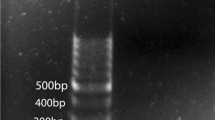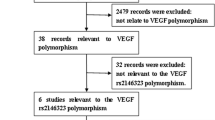Abstract
The present study was aimed to investigate the relation between nuclear factor kappa beta (NFκB) activation and downstream up-regulation of vascular endothelial growth factor (VEGF) in diabetic retinopathy (DR). Moreover the study was intended to evaluate the role of VEGF gene single nucleotide polymorphisms (SNPs) in DR occurrence and to investigate the functional relevance of VEGF gene SNPs in terms of VEGF expression in DR. Serum level of VEGF, VEGF R1 (receptor 1), VEGF R 2 (receptor 2) and NFκB (p50/65) activity was measured by enzyme linked immune sorbent assay. Genotyping and allelic composition of different SNPs i.e., rs2010963, rs3025039, rs1570360 and rs 2071559 were investigated by Taqman SNP genotyping assay. VEGF, NFκB p50/p65, and VEGF R1 & R2 gene expressions were quantified by real time quantitative polymerase chain reaction. Increased NFκB p50/p65 activity and expressions were observed in non proliferative diabetic retinopathy (NPDR) and proliferative diabetic retinopathy (PDR) subjects compared to type 2 diabetes mellitus without retinopathy (DNR) group. Significantly elevated levels of serum VEGF and highest VEGF expression were found among PDR subjects compared to DNR or NPDR subjects. CC genotype and C allele of rs2010963 and TT genotype and T allele of rs3025039 were significantly over represented among PDR subjects compared to DNR group. Increased activation of NFκβ in NPDR and PDR subjects might involve increased up regulation of VEGF. VEGF SNPs i.e., rs2010963 C allele and rs3025039 T allele might be associated with PDR occurrence and in turn regulates VEGF expression among PDR subjects.



Similar content being viewed by others
References
Cai J, Boulton M (2002) The pathogenesis of diabetic retinopathy: old concepts and new questions. Eye 16:242–260
Chakraborti S, Cukiernik M, Hileeto D et al (2000) Role of vasoactive factors in the pathogenesis of early changes in diabetic retinopathy. Diabetes Metab Res Rev 16:393–407
Meteoglu I, Erdogdu IH, Meydan N et al (2008) NF-kappaB expression correlates with apoptosis and angiogenesis in clear cell renal cell carcinoma tissues. J Exp Clin Cancer Res 27:53–61
Neufeld G, Cohen T, Gengrinovitch S et al (1999) Vascular endothelial growth factor (VEGF) and its receptors. FASEB J 13:9–22
Stone J, Chanling T, Peer J et al (1996) Roles of vascular endothelial growth factor and astrocyte degeneration in the genesis of retinopathy of prematurity. Investig Ophthalmol Vis Sci 37:290–299
Shweiki D, Itin A, Soffer D et al (1992) Vascular endothelial growth factor induced by hypoxia may mediate hypoxia initiated angiogenesis. Nature 359:843–845
La Rosa S, Uccella S, Finzi G et al (2003) Localization of vascular endothelial growth factor and its receptors in digestive endocrine tumors: correlation with microvessel density and clinicopathologic features. Hum Pathol 34:18–27
Shukla S, Maclennan GT, Fu P et al (2004) Nuclear factor-κB/p65 (Rel A) is constitutively activated in human prostate adenocarcinoma and correlates with disease progression. Neoplasia 6(4):390–400
Schmid H, Boucherot A, Yasuda Y et al (2006) Modular activation of nuclear factor-κβ transcriptional programs in human diabetic nephropathy. Diabetes 55:2993–3003
Aggarwal BB (2004) Nuclear factor-kappaB: the enemy within. Cancer Cell 6:203–208
Siebenlist U, Franzoso G, Brown K (1994) Structure, regulation and function of NF-κβ. Ann Rev Cell Biol 10:405–455
Baldwin AS (2001) Series introduction: the transcription factor NF kappa B and human disease. J Clin Investig 107:3–6
Tak PP, Firestein GS (2001) NF-kappa B: a key role in inflammatory diseases. J Clin Investig 107:7–11
Aggarwal BB (2003) Related articles, links abstract signaling pathways of the TNF superfamily: a double-edged sword. Nat Rev Immunol 3:745–756
Mohamed AK, Bierhaus A, Schiekofer S et al (1999) The role of oxidative stress and NF-κβ activation in the late diabetic complications. BioFactors 10:157–167
Wirostko B, Wong TY, Simo R (2008) Vascular endothelial growth factor and diabetic complications. Prog Retin Eye Res 27:608–621
Frank RN (2004) Diabetic retinopathy. N Engl J Med 350:48–58
Awata T, Kurihara S, Takata N et al (2005) Functional VEGF C—634G polymorphism is associated with development of diabetic macular edema and correlated with macular retinal thickness in type 2 diabetes. Biochem Biophys Res Commun 333:679–685
Awata T, Inoue K, Kurihara S et al (2002) A common polymorphism in the 5'—Untranslated region of the VEGF gene is associated with diabetic retinopathy in type 2 diabetes. Diabetes 51:1635–1639
Churchill AJ, Carter JG, Ramsden C et al (2008) VEGF polymorphisms are associated with severity of diabetic retinopathy. Investig Opthalmol Vis Sci 49(8):3611–3616
Choudhuri S, Dutta D, Sen A et al (2013) Role of N–epsilon- carboxy methyl lysine, advanced glycation end products and reactive oxygen species for the development of nonproliferative and proliferative retinopathy in type 2 diabetes mellitus. Molvis 19:100–113
Vermeulen L, De Wilde G, Notebaert S et al (2002) Regulation of the transcriptional activity of the nuclear factor kappaB p65 subunit. Biochem Pharmacol 64:963–970
Pahl HL (1999) Activator and target genes of Rel/NF-kappa B transcription factors. Oncogene 18:6853–6866
Hofmann MA, Schiekofer S, Kanitz M et al (1998) Insufficient glycemic control increases nuclear factor-κβ binding activity in peripheral blood mononuclear cells isolated from patients with type 1 diabetes. Diabetes Care 21:1310–1316
Ha H, Yu MR, Choi YJ et al (2002) Role of high glucose induced Nuclear factor-κβ activation in monocyte chemo attractant protein-1 expression by mesangial cells. J Am Soc Nephrol 13:894–902
Romeo G, Liu WH, Asnaghi V et al (2002) Activation of nuclear factor-κβ induced by diabetes and high glucose regulates a proapoptotic program in retinal pericytes. Diabetes 51:2241–2248
Perrin RM, Konopatskaya O, Qiu Y et al (2005) Diabetic retinopathy is associated with a switch in splicing form anti to pro-angiogenic isoforms of vascular endothelial growth factor. Diabetologia 48:2422–2427
Quam T, Xu Q, Joussen AM et al (2001) VEGF initiated blood retinal barrier break down in early diabetes. Investig Ophthalmol Vis Sci 42:2408–2413
Evans JL, Goldfine ID, Maddux BA et al (2003) Are oxidative stress—activated signalling pathways mediators of insulin resistance and β-cell dysfunction? Diabetes 52:1–8
Purves T, Middlemas A, Agthong S et al (2001) A role of mitogen activated protein kinases in the etiology of diabetic neuropathy. FASEB J 15:2508–2514
Yoshida S, Ono M, Shono T et al (1997) Involvement of interleukin-8, vascular endothelial growth factor and basic fibroblast growth factor in tumor necrosis factor alpha dependent angiogenesis. Mol Cell Biol 17:4015–4023
Kiriakidis S, Andreakos E, Monaco C et al (2003) VEGF expression in human macrophages is NFκβ dependent: studies using adenoviruses expressing the endogenous NF-κβ inhibitor IκBα and a kinase defective form of the IκB kinase 2. J Cell Sci 116:665–674
Evans JL, Goldfine ID, Maddux BA et al (2002) Oxidative stress and stress activated signaling pathways: a unifying hypothesis of type 2 diabetes. Endocr Rev 23(5):599–622
Watson CJ, Webb NJ, Bottomley MJ et al (2000) Identification of polymorphisms within the vascular endothelial growth factor (VEGF) gene: correlation with variation in VEGF protein production. Cytokine 12:1232–1235
Witmer AN, Vrensen GF, Van Noorden CJ et al (2003) Vascular endothelial growth factor and angiogenesis in eye disease. ProgRetin Eye Res 22:1–29
Lu Y, Shi Y, Ge Y et al (2012) Two polymorphisms (rs699947, rs2010963) in the VEGF A gene and diabetic retinopathy: an updated meta-analysis. J Diabetes Metab 3:1–4
Kim HW, KoGj Kang YS et al (2009) Role of the VEGF 936 C/T polymorphism in diabetic microvascular complications in type 2 diabetic patients. Nephrology 14(7):681–688
Yang X, Deng Y, Gu H et al (2011) Polymorphisms in the vascular endothelial growth factor gene and the risk of diabetic retinopathy in Chinese patients with type 2 diabetes. Molvis 17:3088–3096
Chun MY, Hwang HS, Cho HY et al (2010) Association of vascular endothelial growth factor polymorphisms with non-proliferative and proliferative diabetic retinopathy. J Clin Endocrinol Metab 95(7):3547–3551
Watson CJ, Webb NJ, Bottomley MJ et al (2000) Identification of polymorphisms within the vascular endothelial growth factor (VEGF) gene: correlation with variation in VEGF protein production. Cytokine 12:1232–1235
Koukourakis MI, Papazoglou D, Giatromanolaki A et al (2004) VEGF gene sequence variation defines VEGF gene expression status and angiogenic activity in non-small cell lung cancer. Lung Cancer 46:293–298
Funding
The research work was funded by intramural Grant of Indian Council of Medical Research (ICMR Project No.52/2/2007-BMS), Government of India.
Conflict of interest
The authors declare that there is no conflict of interest associated with this manuscript.
Author information
Authors and Affiliations
Corresponding author
Electronic supplementary material
Below is the link to the electronic supplementary material.
Rights and permissions
About this article
Cite this article
Choudhuri, S., Chowdhury, I.H., Das, S. et al. Role of NF-κB activation and VEGF gene polymorphisms in VEGF up regulation in non-proliferative and proliferative diabetic retinopathy. Mol Cell Biochem 405, 265–279 (2015). https://doi.org/10.1007/s11010-015-2417-z
Received:
Accepted:
Published:
Issue Date:
DOI: https://doi.org/10.1007/s11010-015-2417-z




